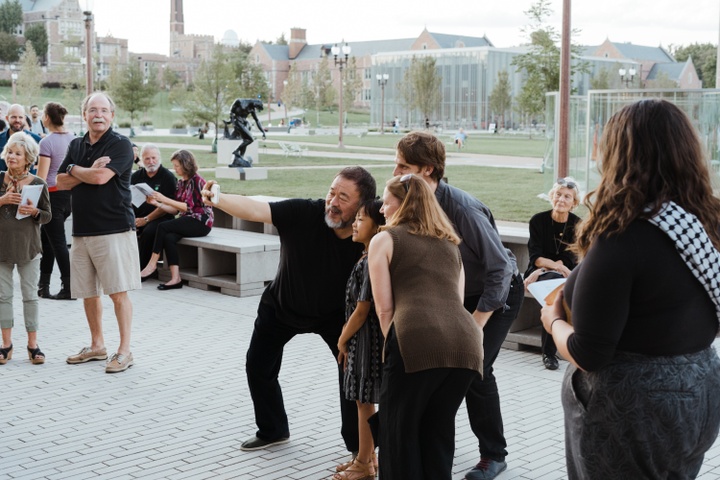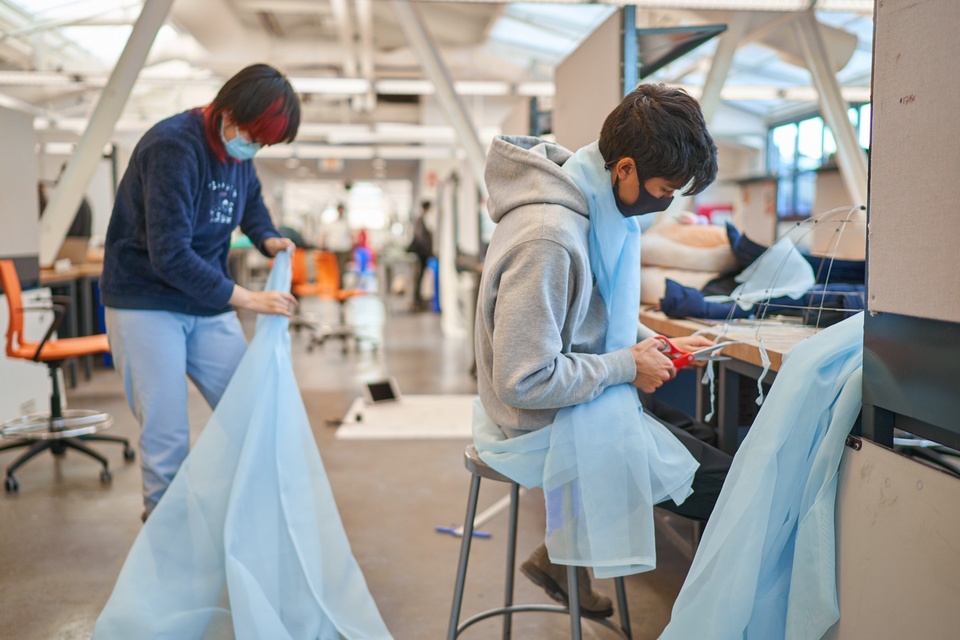Events & Workshops
Public Lecture Series
The Sam Fox School’s annual Public Lecture Series brings nationally and internationally recognized architects, artists, designers, landscape architects, urban designers, historians, and critics to campus, promoting new ideas in practice, theory, and technology. Speakers often engage with students through studio visits and informal exchanges, in addition to their talks.
Fox Fridays
Fox Fridays is a weekly, low-stress workshop series introducing the WashU community to overlooked or under-known tools, resources, processes, and ideas. It provides a platform for students to develop hybridized practices of creative output that transcend discipline, medium, and experience.
Laskey Charrette
The Laskey Charrette honors the late professor emeritus Leslie J. Laskey and his singular approach to design education during his 35-year tenure at Washington University. For this intensive, weekend-long workshop, second-year architecture students work in teams to brainstorm ideas for a given design challenge. Their final designs are exhibited and reviewed, with a jury of faculty awarding prizes. The charrette is presented annually by Studio L in collaboration with the College of Architecture and Graduate School of Architecture & Urban Design.
For more information about Studio L and the Laskey Charrette, email studiolaskey@gmail.com.
2022 Charrette
Yasmin Vobis (RA, NCARB), co-principal of Ultramoderne and an assistant professor of architecture at Harvard Graduate School of Design, served as the moderator of the 2022 Laskey Charrette, which took place February 4-6.
The team of Dear Liu, Jack Zhang, and Kaiwen Wang took first place in this year’s charrette. Check out this news announcement for the full list of winning teams, as well as photos from this year’s charrette. You can also view a recording of Vobis’ public lecture, introducing this year’s design brief, A HAT IS A HOUSE, which called upon the students to work in teams to “expand the definition of a hat to blur the line that differentiates the personal from the collective,” culminating in the creation of a hat that could be worn by one or multiple people.
2020
Moderator: Aki Ishida
1st Place ($1,500): Model T—Lisa Chen, Spencer Derthick, Andy Entis, and Risako Nozaki
Honorable Mention: Folds & Gaps—Connor Merritt, Annika Pan, and Yuwei Yang
Honorable Mention: Divergence—Malik Gaye, Christa Hua, Allen Liang, and Caleb Ullendorff
Honorable Mention: Circuit—Caroline Denk, Xiaowen Ma, and Emily Rupright
Read the news announcement | View photos
2019
Moderator: Jerry Kugler
1st Place ($1,500): Lotus—Claude Luo, Francois Savignac, Juno Zhu, Xiaofan Hu
Honorable Mention: Stalaglite—Tony Chen, Malika Johnson, Brittany Heller, Zach Adams
Honorable Mention: The Light Box—Brooke Bulmash, Yihan Huang, Sam Rho, Basil Frost
Read the news announcement | View photos
2018
Moderator: Ian Monroe (BFA95)
1st place award ($1,500): Team No. 5—John Adrian Anak Christopher, Sebastian Bernal, Wentao Guo
Honorable Mention: Team No. 2—Dylan Chan, Qian Huang, Philipp Kentner, Thomas Spalter
Honorable Mention: Team No. 8—Yutong Ma, Graham McAllister, Taili Zhuang
2017
Moderator: Elizabeth O'Donnell, AIA
Team A—Caroline Amstutz, Martine Kushner, KJ Jiaheng Kuang, and Rodrigo Poma
Team B—Jenna Schnitzler, Marcellus Johnson, Katie Engelmeyer, and Tiffany Zheng
Team C—Maddie Farrer, Corrina Thompson, Eleanor Knowles, and Mesha Bisarya
2016
Moderator: Erik M. Hemingway
First Prize: Team of Gus Anderson, Eve Bobrow, and Qin Ye Chen
Honorable Mention: Team of Kristen Patino, Yulin Peng, and Rebecca Resnic
Honorable Mention: Team of Jenny Li, Mingxi Li, and Yin Li
2015
Moderators: Laura and Rick Brown (MFA75)
First prize: Team of Aria Griffin, Nina Lang, and Alicia Morris
Honorable Mention (book award): Team of Ciara Hackman, James McClanahan, and Lucas Rasmussen
Honorable Mention (book award): Team of Jack Lynch and Joshua Stevens
2014
Moderator: Ted Krueger
First prize: Team of Benjamin Aiken, Olivia Bolton, and Guangdi Yao
Honorable Mention: Team of Elizabeth Brown, Carley Ream, and Min Suk Yang
Honorable Mention: Team of Ailing Zhang and Jie Fu
2013
Moderator: Mehrdad Hadighi
First prize: Team of Casey Federbusch (art), Taylor Halamka (architecture), Edenton Lewis (art), and Caitlin Watanasiri (art)
Book Award: Two teams, featuring Alexandra Chiu (art), Rebecca Curtis (architecture), Grace Davis (architecture), Shira Grosman (architecture), Isaac Howell (art), Patricia Kilbride (art), Wonjin Son (art), and Maya Theus (art)
2012
Moderator: Kyna Leski
First prize: Team of Eric Zuckerman (Architecture), Ben Zunkeler (Architecture), Anna Darling (Architecture), and Cherise Matthew (Art) for “Felt Detergent”
Book award: Team of Grant McCracken (Architecture), Nicole Yen (Art), Weiqian Liu (Architecture), and Martin Lockman (Architecture) for “Principa Mathematica”
Honorable Mention: Team of Elaine Stokes (Architecture), Adam Strobel (Architecture), and Elizabeth Korb (Art) for “Tangerine Peel”
Honorable Mention: Team of Allison Balogh (Architecture), Quamesha Brown (Art/Architecture), Jordan Rapp (Architecture), Elliot Petterson (Architecture), and Esther Hamburger (Art) for “Log”
Honorable Mention: Team of Stephanie Silva (Architecture), Sam Stapleton (Architecture), Claudia Frolova (Art), and Madeleine Docherty (Art) for “Rainbow Reproduction”
2011
Graduate architecture students Lavender Tessmer and Andrea Fisk for “Hang-Out”
2010
Graduate architecture students Akshita Sivakumar and Stephen Kim for “100+”
Fitzgibbon Charrette
The annual Fitzgibbon Charrette is a one-day sketch problem for all juniors and seniors in architecture.
2022 Charrette
Dwayne Oyler and Jenny Wu, founders of the experimental architecture and design firm Oyler Wu Collaborative, served as the moderators for the 2022 Fitzgibbon Charrette, delivering an online kickoff lecture on February 25.
This year’s prompt focused on creating methods of assembly that require an intense investigation of architectural parts, and that allow for a transference between types and scales. Each team of students created “a puzzling architectural assembly” using a combination of architectural and industrial parts. The “parts” were derived from two to three previous architectural studio projects, as well as an assigned tool model.







































